Dingo 1
The need for a new form of AFV became painfully apparent to the western coalition forces in 2002 as they transitioned from the high intensity engagements with the Taliban to military occupation duties. Lightly armoured vehicles like the HMMWV faced ever grater danger from Taliban ambushes and IED attacks. Vehicles within the coalition’s arsenal were either to oheavy leading to damage to public infrastructure or too light, lacking in protection.

This need was not an entirely new thing. During operations in the Balkans in 1995 German high command had already noticed the lack of decently protected road mobile vehicles in their arsenal. To provide such protection in the short-term existing vehicles had addon armour kits installed. Such kits were installed on the Fuchs, various engineering vehicles and several logistics vehicles.

While the kits offered protection against anti-personnel mine sand small arms fire, they lacked the ability to withstand anti-tank mines. Thus, the need for a new well protected but highly mobile vehicle filling the gap between the Wolf and Fuchs was envisioned.
South Africa with its prior experiences in operations against communist insurgents and the war in Angola had already made a drastic HeadStart in the development of mine-resistant vehicles. The Buffel, Rattel and Caspir all features a V shaped hull that acted as a blast deflector and while not specifically designed for it they also offered a degree of protection against anti-tank mines.
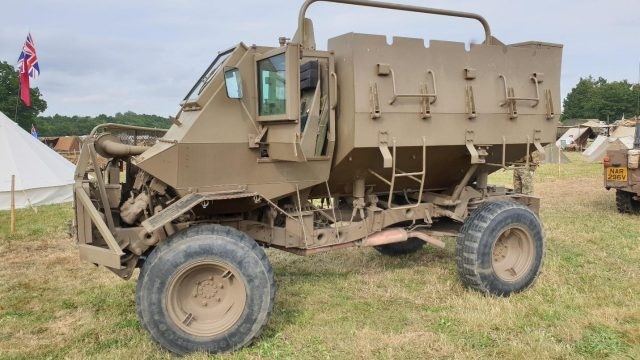
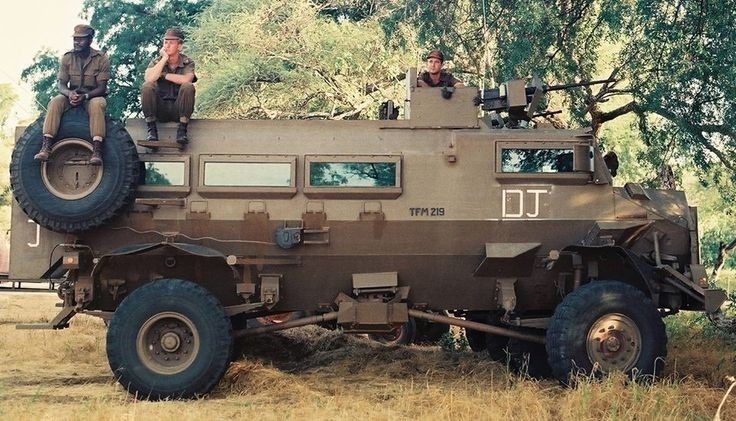
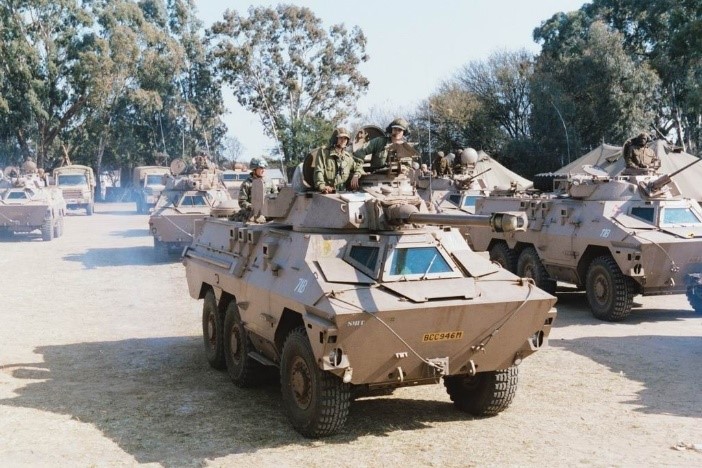
A prototype for a mine blast deflector was developed based on south African implementations on their vehicles. This was done is the second halve of the 90’s under Army Project 41. This deflector was then paired with an armoured cab and troops compartment after which it was installed on the chassis of a Unimog U 100L by KMW with assistance from the German procurement agency and Ingenieurbüro Deisenroth.

This vehicle became the Allzweck-Transport-Fahrzug 1 or ATF 1 for short. While the vehicle met the protection requirements, cross-country mobility was deemed to be lacking. A change to the UNIMOG U 1550L chassis solved this problem.

The new vehicle dubbed ATF2 met the mobility needs while also offering a higher load capacity. The vehicle was tested both by KMW internally and by several German Military Proofing grounds. After this the ATF 2 was shown of at multiple military schools. Here however it was received with very little enthusiasm as all attention was going towards the GTK Boxer which was being developed at the same time.
Even after the vehicle was presented to Army Forces Command in Koblenz in 1999 no actual plans for it’s adoption were put forward. This would however change rather quickly in the following months.

The cancelation of the SuperFuchs program and a mine-strike on a Fuchs operating in Macedonia quickly prompted a request for a market analysis and procurement plan to once again address this capability gap. The initial findings of the study showed that only foreign produced options existed on the open market. It was here that the principal Armaments Department suggested taking a second look at the ATF2.
On the 18th of October the principal Armaments Department received and urgent operational requirement for the KFOR mission. This UOR was for almost 40 vehicles which would receive the Dingo designation. The procurement project had a budget of 42 million Deutsche Mark. Part of this was already paid out to KMW before the complete budget was approved so that the company could immediately work on ordering the needed UNIMOG chassis. The development of a logistics system was called of but later budget provisions allowed for the procurement of spare parts under the initial contract with KMW.
Additional parts and maintenance support came from Daimler-Benz’s international support network which reduced the maintenance risk of the vehicle to a “manageable” level in the eyes of the principal Armaments Department. Only 3 days later on the 21st of October then defence minister Rudolf Shulz approved the procurement of the ATF Dingo 1. The budget committee gave its approval on the 15th of December and the contract with KMW was signed on the 16th.
In total this contract saw 56 vehicles ordered with the first 2 leaving the production floor on the 24th of August 2000. By the end of 2000 all 56 vehicles were delivered to the Bundeswehr. These vehicles would immediately be sent to units in Kosovo and North-Macedonia. Here it operated alongside Luchs, Wolf and Fuchs as a mine protected companion for these vehicles.

Feedback by the troops using it saw a handful of safety modifications made to the vehicle as well as an adjustment to its suspension as it was deemed to be too “soft” which increased the change of the vehicle rolling over. The positive feedback of its users saw a second lot of 57 vehicles ordered by November of 2001 and a third lot of 34 vehicles in March 2002. In total Germany procured 147 ATF Dingo 1’s.
The ATF Dino 1 was taken out of production after the third lot was delivered as Daimler-Benz ended production of the UNIMOG U 1550L vehicles.
Protection on the ATF Dingo 1 consisted of all round STANAG 4569 Level 3 ballistic protection and level 2+ mine-protection. The cab itself consists of a steel structure with externally mounted composite armour plates. Additionally, a spall liner was installed.

The doors are equipped with a locking mechanism that will keep them closed in case of a Mine blast under or near the vehicle to better protect the vehicles occupants. The Dingo 1 has a crew of 5 consisting of a commander, driver, gunner and 2 dismounts. Each crew member has a seat with 4-point seatbelt from Schroth Safety Products.
The vehicles communication equipment consisted of a SEM 80/90 radio system positioned between the driver and commander and a SEM 52 handheld radio. An onboard communication system for the crew and GPS were also installed.

Additional equipment as well as the body armour of the driver and gunner was stored the rear storage compartment which has a 2m³ volume. On top of this there are storage spaces in the doors and special mounts for the crews’ rifles.

The Dingo 1 is armed with an MG3A1 T 7,62x51mm machine gun that was manually aimed from under armour protection. For aiming the weapon is equipped with a 4x magnification sight to which a night vision adaptor can be mounted.

Variants
- ATF Dingo 1 EMU; A Dingo 1 fitted with an electronic counter measure system for mines and IED’s. The rear storage compartment also received a hardtop cover instead of the tarp on the regular Dingo 1.

- ATF Dingo 1 Feldjägertrupp; Military police variant of the Dingo 1 equipped with police lights and a hardtop cover for the rear storage compartment.

- ATF Dingo TOG; Variant of the Dingo 1 equipped with a loudspeaker system.

- ATF Dingo 1 Kuckuck; A variant belonging to the German military intelligence service. No further information about the vehicle is known. The vehicle can be recognised from its (assumed) additional antenna mounts.

Export
Other than Germany only one other military force adopted the ATF Dingo 1. This was Kurdistan whom was given 5 ATF Dingo 1 in 2014 as part of an aid package from Germany to combat ISIS along with 101 other vehicles. These were 60 LKW Wolf, 40 LKW Unimog and 1 fuel tanker truck. An interesting note is that these vehicles did not have their BW marking removed like is the case with vehicles now being donated to Ukraine.


Dingo 2
With 147 vehicles build the Dingo 1 would no longer be build as the UNIMOG U 1550L left production. Thus, KMW started to look for a new chassis and eventually settled on the UNIMOG U 5000 series.

Development of this Dingo 1 replacement was already underway when the Dingo 1 was still being build. In 2003 Germany financed the production of a demonstrator vehicle with KMW building a second one from their own funds. Testing of these 2 demonstrators by KMW and the BWB started in November 2003 and lasted till May 2004. With the test providing satisfactory results 52 units of the new named ATF Dingo 2 were procured by 2005 for 36 million €.

The U 5000 chassis was slightly longer than that of the 1550L which allowed for the installation of an additional seat bringing the vehicle crew to 6 soldiers. Mine protection was also to Level 3A.

Variants
- ATF Dingo 2 GE A1; The first production model of the Dingo 2. Ballistic protection on the Dingo 2 is the same as on the Dingo 1 but mine protection was increased.

- ATF Dingo 2 GE A2; An updated version of the GE A1 build in the second production lot. Upgrades include a more powerful engine, combined A/C and NBC system. The vehicles communications equipment also received an update with a Tetrapol radio system, mini-M satcom system for satellite voice and date links and lastly the FUAST C2 system. These systems are installed in addition to the vehicles SEM 80/90 and SEM 52 radios. A rack was also provided for the installation of an additional SEM 93 radio for use by command vehicles. This took the place of the 6th seat but could also be removed to bring the crew back up to 6 if needed.

- ATF Dingo 2 GE A2.1 CG-11; An ATF Dingo GE A2.1 with the CG-11 electronic counter measure system.

- ATF Dingo 2 GE A2.2; A modification of the GE A2that features the PILAR MK2-w gunshot detection system.

- ATF Dingo 2 GE A2.3; Second production lot of the GE A2 which received the FBW 100 and 200 RWS from the factory. Many of the previously delivered Dingo 2 also received these RWS’s.

- ATF Dingo 2 GE A3; A variant of the GE A2.3 specifically developed to equip maintenance units that operated with the Dingo.

- ATF Dingo 2 GE A3.1; A variant of the GE A3 equipped with a loudspeaker system to replace the ATF Dingo 1 TOG.

- ATF Dingo 2 GE A3.2; Another variant of the GE A3 meant for logistics duties but also often used to transport reconnaissance forces.

- ATF Dingo 2 GE A3.3; A patrol variant of the GE A3 equipped with a new brake system, larger tires, INMARSAT BGAN Explorer 727 satellite communications system and a new GPS system.

- ATF Dingo 2 GE A4; The A4 is the latest variant of the Dingo ordered by Germany. It will be built on a new Unimog chassis from Mercedes-Benz Special Trucks which increases the maximum loaded weight of the vehicle from 13,8 to 14,5 tonnes. In addition to the new chassis the vehicle will also receive a new 240KW engine. A framework agreement with KMW was signed for 233 units of which 50 have been ordered to backfil donations to Ukraine.
- ATF Dingo 2 GE C1; Maintenance and engineering variant of the Dingo 2. The vehicle has a reduced crew capacity of 3 people and a smaller fuel tank. The rear section of the vehicle was replaced with additional storage space and a small workshop.
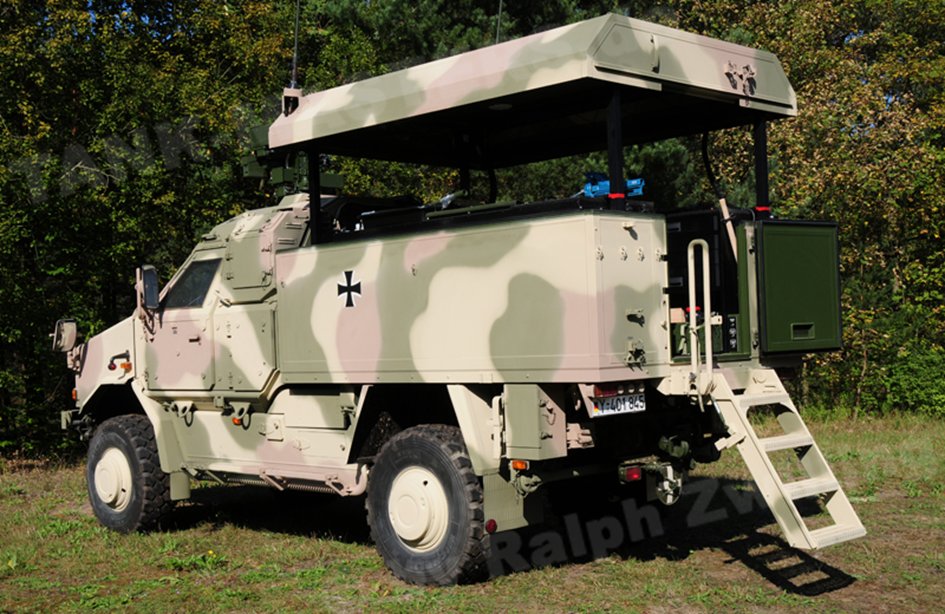
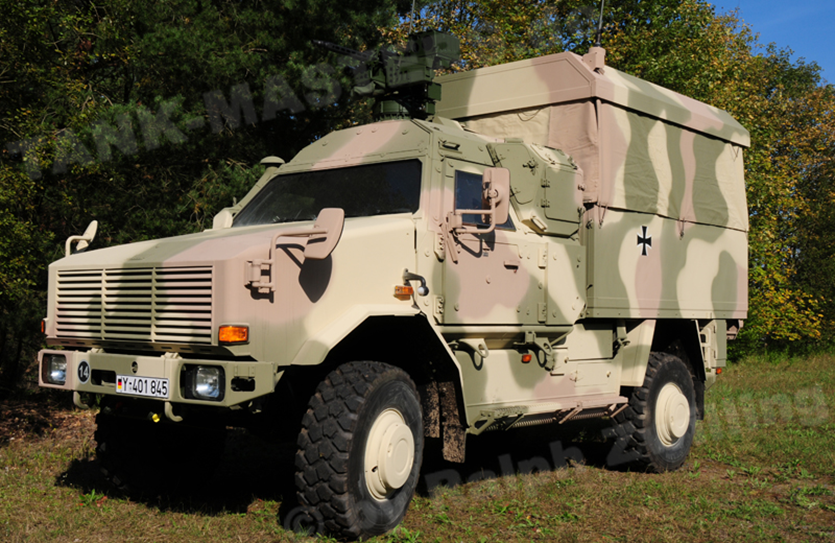
- ATF Dingo 2 GE D1/D2; Variant of the Dingo 2 equipped with an AEDS ground surveillance radar.

By 2012 Germany had already purchased more then 600 ATF Dingo 2 but by late 2023 this has turned into almost 700 vehicles. The sourcing around this is not 100% reliable as my primary source for all but the A4 variant was written in 2011.

Export
Next to Germany 6 other military’s decided to purchase the Dingo 2. At total of 438 Dingo 2 were delivered under these export contracts.

Ukraine
Ukraine has had 2 countries pledge Dingo 2’s to it. Germany pledged 50 units while Norway has is set to deliver a number of tier Dingo 2’s equipped with CORTEX Typhon RWS.

The vehicles from Germany are older A1 and A2 models that still have the older type 1530 weapon station armed with a MG3A1 T instead of the newer models with FLW 100 and 200 Remote weapons stations.
In Ukrainian service the Dingo has been seen with the 77th Air Mobile Brigade which has used them during the battle for Bakhmut.

Sources
- Diese Waffen liefert Deutschland an die Kurden
- 77th Airmobile Brigade
- ATF Dingo
- Nachbeschaffung Dingo 2 A4 unter Vertrag
- Allschutz Fahrzeug Dingo 2 – lang
- BW – PROTECTED WHEELED VEHICLES
- The battle in Ukraine is now ‘a hell of attrition’, as trench warfare rages in Bakhmut | Daily Mail Online
- llschutz-Transportfahrzeug (ATF 2) Dingo 1 (Bw)
- Tankograd Militaïrfahrzeug Spezial n° 5037 Dingo 2 – Das Allschutz-Transportfahrzeug in der Bundeswehr written by Ralph Zwilling
- Tankograd Militaïrfahrzeug Spezial n° 5036 Das Allschutz-Transportfahrzeug (ATF) Dingo 1 in der Bundeswehr written by Ralph Zwilling
